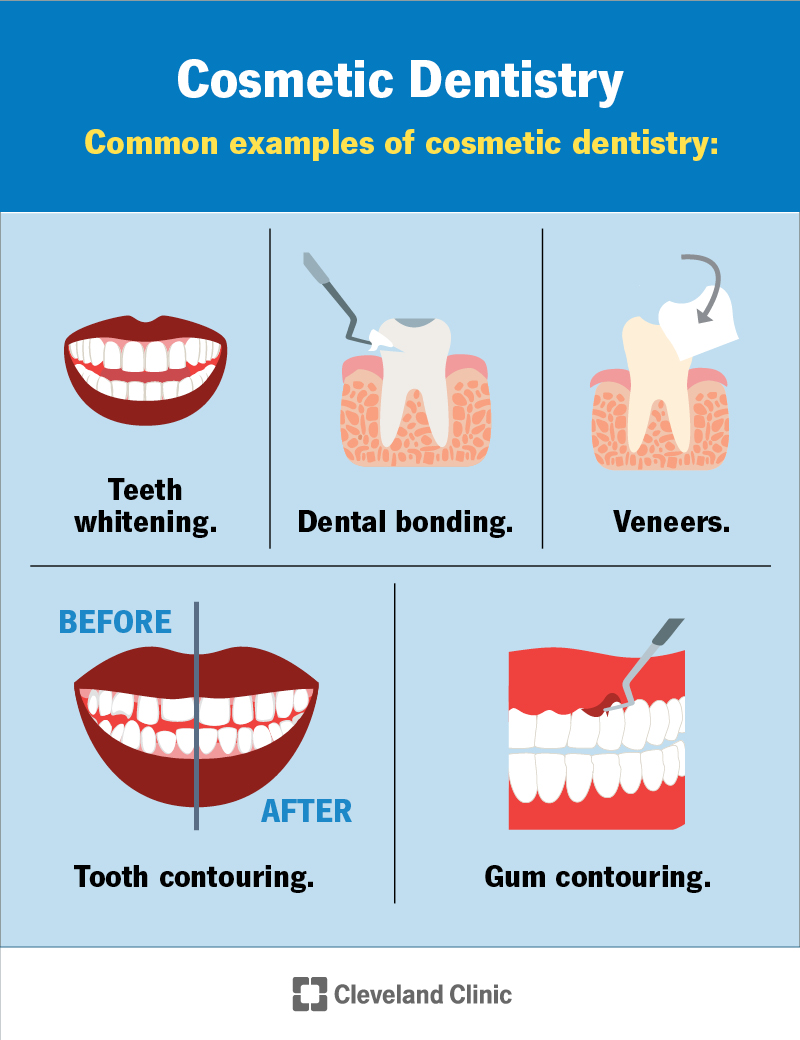Cosmetic dentistry is the branch of dentistry that focuses on improving the appearance of your smile. Common cosmetic dentistry services include teeth whitening, dental bonding and veneers. These procedures can enhance your smile by bringing balance and symmetry to your teeth and gums.
Advertisement
Cleveland Clinic is a non-profit academic medical center. Advertising on our site helps support our mission. We do not endorse non-Cleveland Clinic products or services. Policy

Cosmetic dentistry (aesthetic dentistry) focuses on improving the appearance of your smile. Common cosmetic dentistry procedures include teeth whitening, dental bonding and veneers.
Advertisement
Cleveland Clinic is a non-profit academic medical center. Advertising on our site helps support our mission. We do not endorse non-Cleveland Clinic products or services. Policy
You might choose to see a cosmetic dentist if you have:
Cosmetic dentistry aims to create a more balanced, symmetrical and aesthetically pleasing smile. Common cosmetic dental services include both nonsurgical and surgical treatments like:
Advertisement
Cosmetic dentistry services can:
Insurance usually doesn’t cover cosmetic dentistry services. This is because insurance companies don’t consider cosmetic procedures necessary from a health standpoint.
You’ll also need a certain level of commitment to maintain your smile. Some treatments — like porcelain veneers — may be irreversible and require replacement every few years.
It depends on the type of cosmetic procedure and the number of teeth that need treatment. For example, someone who has dental bonding on one tooth can resume normal activities immediately. But someone who has gum contouring may need to take a couple of days off work to recover. Your dentist can tell you what kind of timeline to expect.
Results can last anywhere from a few months to the rest of your life. It depends on the type of procedure you have and how well you take care of your teeth and gums:
| Cosmetic dentistry services | Approximate length of results |
|---|---|
| Teeth whitening | Six months to three years |
| Dental bonding | Five to eight years |
| Veneers | Five to 15 years |
| Tooth contouring | Permanent |
| Gum contouring | Permanent |
| Cosmetic dentistry services | |
| Teeth whitening | |
| Approximate length of results | |
| Six months to three years | |
| Dental bonding | |
| Approximate length of results | |
| Five to eight years | |
| Veneers | |
| Approximate length of results | |
| Five to 15 years | |
| Tooth contouring | |
| Approximate length of results | |
| Permanent | |
| Gum contouring | |
| Approximate length of results | |
| Permanent |
Talk to your dentist any time you’re concerned about the appearance of your smile. They can discuss cosmetic dental options with you.
In the meantime, you should continue seeing your general dentist for routine care, like checkups and cleanings. And don’t forget to practice good oral hygiene at home between visits to keep your teeth and gums healthy.
Wanting to improve your smile doesn’t make you vain. It’s hard to feel confident when there’s something you don’t like about your appearance. You might even avoid certain social situations because of it. There are many cosmetic dentistry treatments available, ranging from simple to complex. Talk to your dentist about your specific cosmetic goals. They can design a treatment plan that works for your budget and lifestyle.
Advertisement
Dentistry plays an important role in oral health. Cleveland Clinic’s experts can design a personalized plan that will keep you smiling for the long haul.

Last reviewed on 11/06/2024.
Learn more about the Health Library and our editorial process.